Homemade Sun Dried Tomatoes
This post may contain affiliate links, which means that I may receive a commission if you make a purchase using these links. As an Amazon Associate I earn from qualifying purchases.
No sunshine required to make these homemade sun dried tomatoes. Drying tomatoes is a great way to preserve the harvest and save storage space. 20 pounds of tomatoes will reduce down to about one pound of sun dried tomatoes.
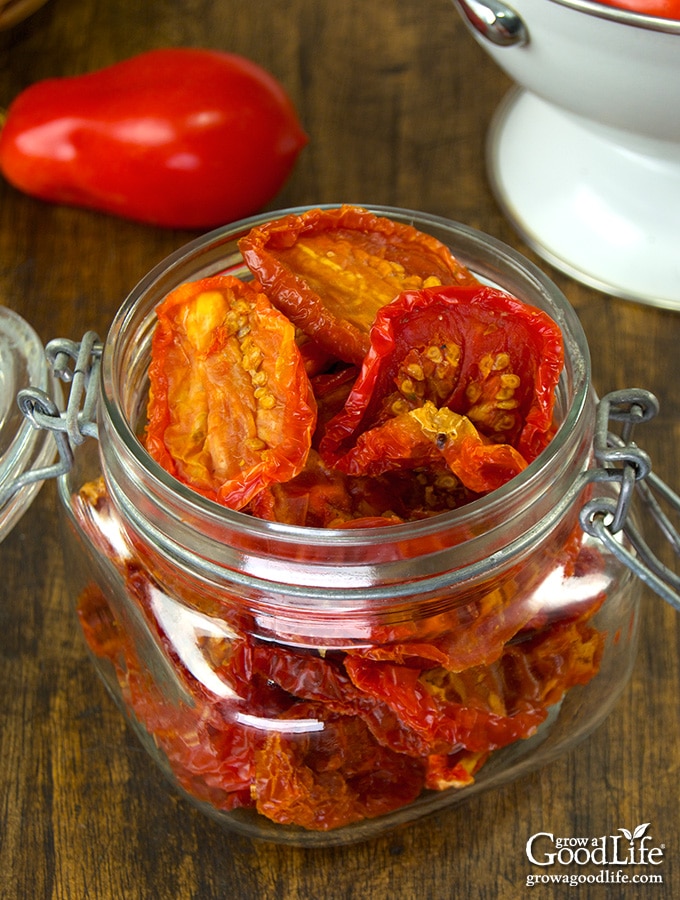
Drying intensifies and sweetens the tomato’s flavor making sun dried tomatoes an ideal snack if you are seeking something a little sweet.
Enjoy dried tomatoes out of the jar as a snack, or chop and use in salads, sandwiches, breads, and even as a pizza topping.
Sun dried tomatoes can be used in so many ways, including sauces, soups, stews, and countless other recipes where you want a punch of deep, concentrated tomato flavor.
What are Sun Dried Tomatoes?
Sun dried tomatoes are ripe tomatoes that have had the moisture removed by drying in the sun, a dehydrator, or an oven. When tomatoes are dried, they lose up to 90% of their water content. Dehydrating tomatoes concentrate the flavors into a sweet, tangy tasting fruit.
3 Ways Sun Dry Tomatoes at Home
When you think of sun-dried tomatoes you probably picture large tables of red tomatoes drying naturally in the sun like they do in southern Italy.
The reality is… most environments are not ideal for drying tomatoes in the sun outside. That’s ok, there are several methods to dry tomatoes at home and make your own tasty sun dried tomatoes.
1. Dry Tomatoes Using the Sun
If you live in a hot, dry climate you may be able to dry tomatoes naturally in the sun. Sun drying can take several days and even weeks. You are aiming for a string of breezy, hot, dry days with a minimum temperature of at least 85˚F (20˚C) and relative humidity below 60%.
Some challenges you may face drying tomatoes outside include theft from bugs, birds, and animals. Cooler nighttime air will also add moisture back into the slowing the drying process. You will need to cover the fruit with a makeshift screen and shuffle the drying trays indoors at night.
You can also get creative and sun dry tomatoes in your car. At least this will protect your tomatoes from birds, bugs, and chipmunks.
2. Use an Oven to Dry Tomatoes
The oven is a great way to dry tomatoes. A low oven delivers consistent, dry heat that allows the moisture to evaporate slowly, within 3-6 hours depending upon the oven temperature, the moisture content and size of your tomatoes.
Unfortunately, peak tomato harvest usually coincides with hot, summer temperatures. Turning on the oven may be the last thing you want to do when it is hot. Aim for cooler evenings or early mornings before the temperatures rise.
The temperature of your oven is important to dry tomatoes properly. You are aiming for a low heat to dry but not cook your tomatoes. If the heat is too hot, you may singe or burn the tomatoes giving them a bitter flavor.
Many ovens don’t give you temperature options under 200˚F. If you do have temperature options on your oven, set it to 150˚F. If not, set your oven to “warm.”
Oven drying requires some monitoring to make sure the tomatoes are drying evenly and the dried pieces are removed before scorching.
3. Make Sun Dried Tomatoes with a Food Dehydrator
Using a food dehydrator is the easiest way to dry tomatoes in a controlled environment.
A dehydrator dries food by circulating warm air through drying screens. For small batch drying, a stackable food dehydrator will serve you well. For larger-scale food dehydrating, consider one of the Excalibur dehydrators.
Yes, technically using an oven or food dehydrator isn’t really “sun-dried,” but for many of us who live in humid locations, it is the only way we can dry tomatoes.
Tips for Drying Tomatoes
I have tried sun drying, oven drying, and dehydrating tomatoes using a food dehydrator.
Sun drying is difficult in my area because the sun isn’t strong enough and there is too much humidity in the air. Oven drying can be tricky. The tomatoes need to be watched to prevent scorching and tend to come out dark and brittle.
My favorite way to sun dry tomatoes is using a food dehydrator. Once the screens are layered with prepared tomatoes, it requires very little attention other than checking every now and then to see if the tomatoes are dry.
Good Types of Tomatoes for Drying
Choose tomatoes with lots of meatiness and flavor for the best homemade sun dried tomatoes.
- Plum tomatoes have meaty flesh and bold flavor suitable for making dried tomatoes. Consider using Amish Paste, Opalka, San Marzano, or any of the Roma types of tomatoes for drying.
- Cherry and grape tomatoes are small globe or plum-shaped fruit that are usually very sweet and flavorful. Principe Borghese tomato is an Italian heirloom that is traditionally used for sun drying. Also consider dehydrating Juliet, Mountain Magic, and any type of flavorful small tomatoes.
- Seriously though, any type of tomato can be dried including beefsteak-slicing tomatoes, such as Cherokee Purple and Brandywine varieties. Even consider drying slices of green tomatoes, and then simply rehydrate and use for your favorite fried green tomatoes recipe.
Cutting Tomatoes for Drying
You will need a good knife to cut the tomatoes without crushing the fruit. Bread knives or even a steak knife with teeth will cut cleanly through the tomato’s skin through the fruit. If you don’t have a serrated knife, use the tip of your knife to break the skin, and then slice through at the same location. Cut your tomatoes into the equivalent size pieces so they dry evenly.
Equipment for Making Sun Dried Tomatoes
Depending on the drying method you choose, here is some helpful equipment for drying tomatoes:
- Baking sheets and cooling racks if oven or sun drying tomatoes
- Food dehydrator
- Storage jars or freezer zipper bags
- Basic kitchen supplies such as kitchen towels, knife, and cutting board.
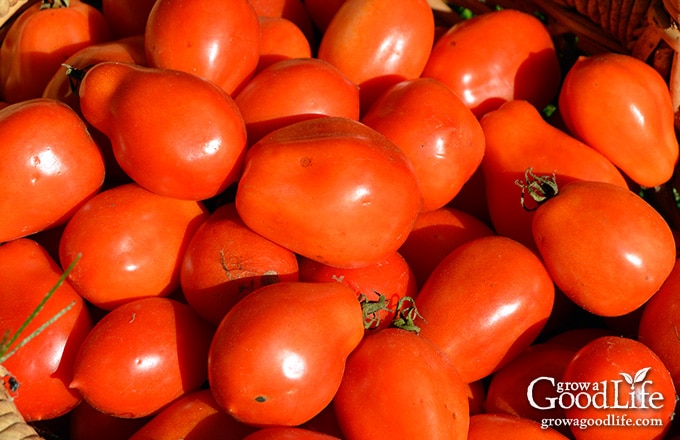
Steps to Making Sun Dried Tomatoes
Step 1: Prepare your tomatoes
Select freshly harvested fruit with no rotten spots or insect damage. Wash your tomatoes well under clean running water and cut into pieces described below:
- Prepare plum shaped tomatoes by trimming off the stem ends and cutting in half, lengthwise. Cut large tomatoes in quarters. If you don’t like the seeds, go ahead and use a spoon to scrape out the seeds and gel without removing the pulp.
- Small cherry and grape tomatoes can simply be sliced in half. Place the tomatoes on your drying screens skin side down to start, and then flip partway through.
- Larger beefsteak tomatoes can be cut into 1/2-inch thick slices. Remove the stem end. Stand the tomato on its side and slice them into rounds horizontally.
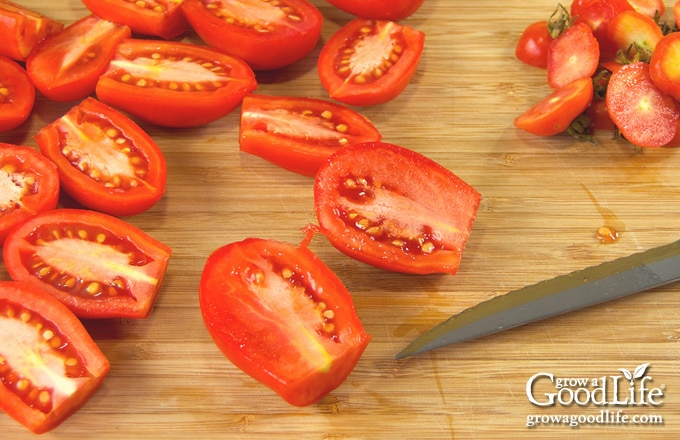
Step 2: Lay out the tomatoes
Arrange the tomatoes in a single layer on your drying screens. Try to leave space in between the pieces so air can circulate around the sides. Place plum and cherry tomatoes with the cut surface up and skin side down. This forms a little cup shape that will prevent the flavorful juices from dripping away.
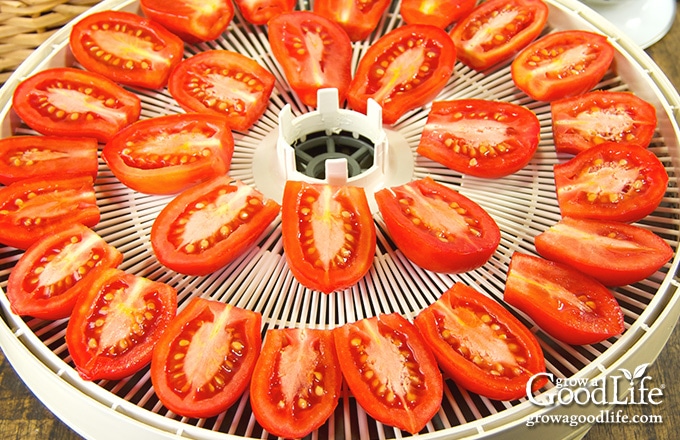
Step 3: Begin drying the tomatoes
Dry your tomatoes using the method you selected: sun, oven, or food dehydrator.
Dry until the tomatoes are shriveled, rubbery, and feel like a raisin. Throughout the drying process, be sure to rotate the baking sheets, flip the tomato pieces over, and remove pieces that have finished drying. Drying time will depend on the method you are using, and the moisture level in the tomatoes and air.
Sun dried tomatoes will remain a bit pliable and chewy. To test for dryness, cut a dehydrated tomato in half and examine the cut edges. If you see moisture in the center, continue drying for a little longer.
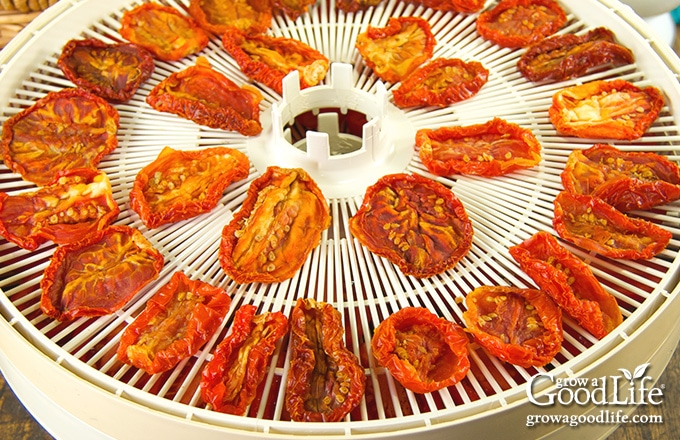
How to Store Dried Tomatoes
After drying, 20 pounds of tomatoes can shrink down to one pound of sun-dried tomatoes.
Store the dried tomatoes in airtight jars. Aim for smaller jars because air is introduced into the dried tomatoes each time you open the jar. Too much moisture could cause the tomatoes to get moldy.
Check the jars over the next week for signs of humidity on the glass. If you see signs of moisture, dehydrate the tomatoes a little longer and repackage.
Store sun dried tomatoes jars in a cool, dark, and dry location for up to one year. You can also store the sun dried tomatoes in zipper bags in the freezer for up to one year.
Ways to Use Sun Dried Tomatoes
Add directly to slow cooked meals: Chop and add dried tomatoes directly to sauces, soups, and stews. They will rehydrate in the liquid as it cooks.
Rehydrate sun dried tomatoes: Bring a pot of water to a boil, turn off the heat, add the sun dried tomatoes, and let them soak until plump up and the skins can be pierced by a knife, about 30 minutes. Remove the tomatoes, blot with a towel, chop, and use in your recipe. Save the tomato liquid for extra flavor.
Make a quick tomato sauce: Rehydrate sun dried tomatoes until soft and then toss into a food processor or blender along with the liquid. Add your favorite Italian spices, garlic powder, and onion powder and puree until smooth.
Puree into tomato powder: If you’ve dried your tomatoes until they are stiff, go ahead and turn the brittle tomato pieces into tomato powder by running them through a blender. Store the tomato powder in jars add to your recipes by the spoonful for a nice tomato flavor.
Like fried green tomatoes? Dehydrate slices of green tomatoes, rehydrate, pat dry, and use them in your favorite fried green tomato recipe.
Homemade Sun Dried Tomatoes
Ingredients
- 20 pounds tomatoes
Instructions
- Wash your tomatoes well under running water.
- Trim off stems and cut the tomatoes into even sized pieces. Slice plum, cherry, and grape tomatoes in half, or into quarters if the tomato is larger than 3-inches. Cut large, round tomatoes into 1/2-inch thick slabs.
To Dry Tomatoes Using the Sun
- Place the tomatoes on the drying screens and cover to protect from insects and pests.
- Dry the tomatoes in the sun or in your car until leathery or brittle, depending on your preference. Shuffle the trays indoors at night and during cloudy rainy periods.
To Oven Dry Tomatoes
- Preheat your oven to 150˚F or its lowest setting.
- Place cooling racks on baking sheets to help air to circulate around the tomatoes as they dry.
- Arrange the tomato pieces in a single layer on the racks leaving space between them so they don't touch. Place plum and cherry tomatoes skin sides down.
- Place the baking sheets in the preheated oven and dry until the tomatoes are shriveled and rubbery. Throughout the drying process, be sure to rotate the baking sheets, flip the tomato pieces over, and remove pieces that have finished drying.
- Drying time will depend on the moisture level in the tomatoes, and can take about 4 to 6 hours.
To dry tomatoes using a food dehydrator
- Set your dehydrator to 135˚F and dehydrate until the tomatoes have shriveled up but remain pliable, around 8-10 hours.
- The time needed to dehydrate the tomatoes will vary depending on the moisture in the tomatoes and the humidity level. When done, your sun dried tomatoes will feel dry but flexible and rubbery.
- Store your sun dried tomatoes in airtight jars. You can also store dehydrated tomatoes in zipper bags in the freezer. Sun dried tomatoes can last up to a year in storage.
Nutrition
You May Also Like
- Seasoned Tomato Sauce Recipe for Canning
- Tomato Salsa Recipe for Canning
- 10 tips to Improve Your Tomato Harvest



should you cut out the white part before drying, doesn’t that get stringy? what temperature and length do you use for the dehydrate method?
Wp, You can cut out the cores if the texture bothers you. For the instructions, including temperature and time, please refer to the recipe in the article.
I was looking for this thank you. I did notice with every drying method you said to rotate them except for the dehydrator method. How often should I rotate the racks? I do know I have to, but was looking for a time frame for rotating them.
Kathy, When using a dehydrator, it’s a good rule of thumb to rotate the racks at least halfway through the drying process. The exact timing can vary depending on your dehydrator model, so it’s a good idea to consult your dehydrator’s manual for specific recommendations. This helps ensure even drying for your fruits or vegetables.
Thank you. This what I was looking for!